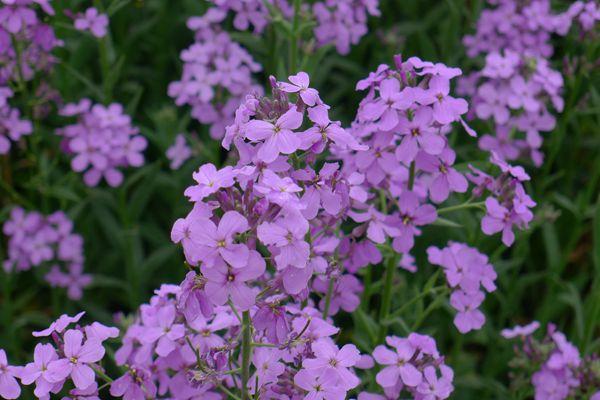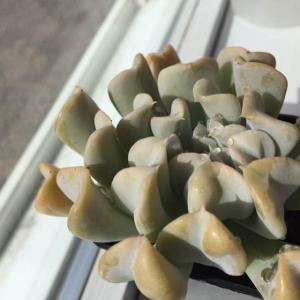文章
Dummer. ゛☀
2017年08月05日

BOTANICAL NAME: Rosmarinus officinalis
PLANT TYPE: Herb
SUN EXPOSURE: Full Sun
SOIL TYPE: LoamySandy
FLOWER COLOR: Blue
Rosemary is a perennial evergreen shrub with blue flowers. It is a pungent and distinctive herb with a sweet, resinous flavor. Here’s how to grow your own rosemary plants.
Rosemary is ideal for a rock garden or the top of a dry wall. It is often used for seasoning poultry, lamb, stews, and soups.
PLANTING
For a head start, plant the seeds or cuttings indoors 8 to 10 weeks before the last spring frost. See your local frost dates.
Plant the seeds/cuttings in well-drained soil. For best growth, the soil should be around 70ºF.
Be sure to give your plants enough room to grow. Rosemary grows to about 4 feet tall and spreads about 4 feet as well.
In the garden, plant near beans, cabbage, carrots, and sage. Learn more about companion planting with herbs.
CARE
After the rosemary plant flowers, remember to trim the plant.
For fresh rosemary in the winter, grow the plant indoors in a pot. Be sure to put it in bright light and cool temperatures.
Prune regularly so that the plant won’t get lanky.
Water the plants evenly throughout the growing season.
Be sure to get cuttings or divide the plant for next season.
PESTS/DISEASES
Aerial blight
Bacterial leaf spots
Several types of root rot
PLANT TYPE: Herb
SUN EXPOSURE: Full Sun
SOIL TYPE: LoamySandy
FLOWER COLOR: Blue
Rosemary is a perennial evergreen shrub with blue flowers. It is a pungent and distinctive herb with a sweet, resinous flavor. Here’s how to grow your own rosemary plants.
Rosemary is ideal for a rock garden or the top of a dry wall. It is often used for seasoning poultry, lamb, stews, and soups.

PLANTING
For a head start, plant the seeds or cuttings indoors 8 to 10 weeks before the last spring frost. See your local frost dates.
Plant the seeds/cuttings in well-drained soil. For best growth, the soil should be around 70ºF.
Be sure to give your plants enough room to grow. Rosemary grows to about 4 feet tall and spreads about 4 feet as well.
In the garden, plant near beans, cabbage, carrots, and sage. Learn more about companion planting with herbs.

CARE
After the rosemary plant flowers, remember to trim the plant.
For fresh rosemary in the winter, grow the plant indoors in a pot. Be sure to put it in bright light and cool temperatures.
Prune regularly so that the plant won’t get lanky.
Water the plants evenly throughout the growing season.
Be sure to get cuttings or divide the plant for next season.

PESTS/DISEASES
Aerial blight
Bacterial leaf spots
Several types of root rot
0
0
Janice Y
2017年07月25日

15 months ago,i bought this very first flower in Germany.It was white,blue and a bit green,so preety.I didn't take good care of it, it almost died.This spring i tried to save it and cut some branches,gave it water wvwey day.Now it's
returns with alive and different colors!







returns with alive and different colors!







2
0
求助
khaki83
2017年07月02日

I know these plants have blue dusting but I touched their leaves way too much and it's lost most of the blue colour, would it ever return blue again?




2
0
khaki83:@Abby Gill thank you so much Abby :) Will be interesting to see. bought this over a month a go now. no development yet
Abby Gill:The powdery substance that makes the plant appear blue is a wax-like material produced by the plant as a sort of homemade sunblock. Succulents were, in the beginning, found in deserts, so many evolved to create this material to protect it from the harsh heat and sunlight. So yes, the blue color will return. Based on the species of your succulent it may either take a few hours to a few days to return. It also depends on the plant's environment and health so don't take my word; it may take weeks. The succulent will most likely be fine during the time without the wax, but I'd refrain from touching the leaves too much in the future. Hope this helped. 🌵🌱💚
sarajordan2993:its beautiful !
khaki83:ah good to know! thank you so much :)
meriunkat:yes over the time it comes back, just takes a while. I have a succulent that also turns blue with the powdery look and I've touched the petals accidentally taking away the blue powder and it came back after some weeks.
文章
Dummer. ゛☀
2017年07月02日

Growth habit of Eurasian mustard
Eurasian mustard is a kind of plant adaptability is strong, when breeding blue incense mustard, usually need full sun environment, appropriate shading in summer time. The soil is generally wet and well drained.
Eurasian mustard breeding is generally self reproduction, generally second years after planting to flower.
The Eurasian mustard flower smells like lilacs.
The flowers and culture of the blue mustard
clustered on the branches, so called wild Phlox, but less than a petal petal phlox.
Morphological characteristics of the mustard blue
Is a perennial or biennial shorter growth period of plants. The vertical height of about 60, much branched, to 90 cm, usually less than 120 cm. 30 ~ 60 cm width. Leaf margin serrate, elliptic to, dark green. Flowers are white, pale purple or purple flower diameter 1.2 ~ 2.4 cm, 4 petals, racemes, and is very similar. Because the flowers and Phlox are similar, are clustered on a long handle, so it is often called the "wild Phlox", but the blue petals less than sweet mustard phlox tablets. Flowers have a clove like scent, especially in the evening, with a strong fragrance.
Per cluster of flowers than , flower shape and color consistency. The seed ratio of small, per kilogram of seed is about 540 thousand grains, and usually less than 400 thousand grains of .



Eurasian mustard is a kind of plant adaptability is strong, when breeding blue incense mustard, usually need full sun environment, appropriate shading in summer time. The soil is generally wet and well drained.
Eurasian mustard breeding is generally self reproduction, generally second years after planting to flower.
The Eurasian mustard flower smells like lilacs.
The flowers and culture of the blue mustard
clustered on the branches, so called wild Phlox, but less than a petal petal phlox.
Morphological characteristics of the mustard blue
Is a perennial or biennial shorter growth period of plants. The vertical height of about 60, much branched, to 90 cm, usually less than 120 cm. 30 ~ 60 cm width. Leaf margin serrate, elliptic to, dark green. Flowers are white, pale purple or purple flower diameter 1.2 ~ 2.4 cm, 4 petals, racemes, and is very similar. Because the flowers and Phlox are similar, are clustered on a long handle, so it is often called the "wild Phlox", but the blue petals less than sweet mustard phlox tablets. Flowers have a clove like scent, especially in the evening, with a strong fragrance.
Per cluster of flowers than , flower shape and color consistency. The seed ratio of small, per kilogram of seed is about 540 thousand grains, and usually less than 400 thousand grains of .



0
0
文章
Dummer. ゛☀
2017年07月01日

The morphological characteristics of color.
Three bindweed is annual or perennial herbs. Stems climbing, ascending, leaves narrowly oblong to , apex obtuse, entire; neck short, sparsely flowered, solitary. Corolla bell shaped or funnel-shaped, blue, red, yellow and white edge, throat, annual, erect or climbing stems, branches and flowers in drooping, white star shaped block, and yellow flower, and the outer ring around a single color red, blue, pink or white flowers that look like, but if only. Open a day, it is true, a flower has three color color.
The growth habit of the three.
In 3 ~ May tricolor sowing, flowering from 6 to July, more open in the morning.
tricolor warm, humid, sunny; lax to requirement, can choose organic builder to cultivate soil for cultivation, soil fertility during the need to keep moist, not dry, and placed in outdoor light, after sowing after about 70 to 90 days will be open to a flower, to one and a half months before flowering, every two weeks a month applying fertilizer, increase the soil fertility and the flowering of bright colors;
A vine with three bindweed, so in the growth period when the stem elongation, can give moderate pruning, and support, to prevent lodging, also can be in pots or hanging flower beds, let it drop growth, is also a good choice.
Three the heat tolerance is good, but when in the summer comes, the hot weather is easy to make the plant significantly weakened, required to maintain the cultivation environment and ventilation; transpiration is fast, the need to pay attention to water supply, but the culture medium used for good drainage, so that the root rot easily in hot and humid conditions. And its cold resistance is also good, so the cultivation period can be extended to early autumn.
cultivation techniques
Most commonly with seeding breeding, sowing period is about in early spring to early summer can be suitable germination of about 18 to 25 DEG C, seeding in seedling tray, thin soil cover, keep the soil moist, in seedling tray coated on the transparent plastic cloth, to keep humidity, but not inside water, about 7 ~ 14 days to germination, then remove the plastic cloth, placed in bright light, the leaves of 3 ~ 5, can be transplanted to the basin, but not resistant seedlings three transplantation, the transplantation need careful attention, also can start live in the basin.



Three bindweed is annual or perennial herbs. Stems climbing, ascending, leaves narrowly oblong to , apex obtuse, entire; neck short, sparsely flowered, solitary. Corolla bell shaped or funnel-shaped, blue, red, yellow and white edge, throat, annual, erect or climbing stems, branches and flowers in drooping, white star shaped block, and yellow flower, and the outer ring around a single color red, blue, pink or white flowers that look like, but if only. Open a day, it is true, a flower has three color color.
The growth habit of the three.
In 3 ~ May tricolor sowing, flowering from 6 to July, more open in the morning.
tricolor warm, humid, sunny; lax to requirement, can choose organic builder to cultivate soil for cultivation, soil fertility during the need to keep moist, not dry, and placed in outdoor light, after sowing after about 70 to 90 days will be open to a flower, to one and a half months before flowering, every two weeks a month applying fertilizer, increase the soil fertility and the flowering of bright colors;
A vine with three bindweed, so in the growth period when the stem elongation, can give moderate pruning, and support, to prevent lodging, also can be in pots or hanging flower beds, let it drop growth, is also a good choice.
Three the heat tolerance is good, but when in the summer comes, the hot weather is easy to make the plant significantly weakened, required to maintain the cultivation environment and ventilation; transpiration is fast, the need to pay attention to water supply, but the culture medium used for good drainage, so that the root rot easily in hot and humid conditions. And its cold resistance is also good, so the cultivation period can be extended to early autumn.
cultivation techniques
Most commonly with seeding breeding, sowing period is about in early spring to early summer can be suitable germination of about 18 to 25 DEG C, seeding in seedling tray, thin soil cover, keep the soil moist, in seedling tray coated on the transparent plastic cloth, to keep humidity, but not inside water, about 7 ~ 14 days to germination, then remove the plastic cloth, placed in bright light, the leaves of 3 ~ 5, can be transplanted to the basin, but not resistant seedlings three transplantation, the transplantation need careful attention, also can start live in the basin.



1
0
文章
Dummer. ゛☀
2017年07月01日

Another name for blue daisy
The other name for "Blue Daisy" is African marigold, African Daisy and large flowered blue daisy.
Growth habit of blue eye Chrysanthemum
Blue eye chrysanthemum, originating from South Africa, like sunny and cool climate, avoid hot and cold. In the cultivation of the soil requirements are lax, good drainage can be.
When the reproduction of blue eye chrysanthemum, generally choose the spring sowing method, can also in autumn.
The plant is medium, with beautiful flowers. Blue eye chrysanthemum flowers solitary, open flower, blue and purple flower is.
Morphological character
The plant height of blue daisy is below 60cm. Basal Ye Congsheng, cauline leaves alternate, oblong to obovate, usually pinnately lobed, entire or slightly serrate, with white hairs when young leaves. Flower diameter of 7.5 cm or so, ligulate flower white, apex acuminate, abaxially pale purple to purple disc. There are single, double points. Flowering, summer and autumn.
Often confused with South African marigold flowers, the leaves of the 1 and Echinacea leaves are usually pinnately divided, whereas South African marigold flowers (blue eyes) do not normally split. 2 flowers, blue eye chrysanthemum flower, the flower, only the blue (blue eyes), South African marigold blue, yellow and purple, generally speaking, in the blue eyes of chrysanthemum, kind of cold tolerance will be dark blue in the central part (flower; edge, blue eye chrysanthemum only flower) a white, South African marigold (blue eyes) with purple, pink and white, yellow and other colors.
Propagation by sowing or cutting. autumn .
The ground should be planted with plenty of sunshine; the pot is made of loam and rotten leaves, and some sand is added to it. Blue eye chrysanthemum can be used for flower border, or flowers, water for long periods of time.
The flower language of the blue daisy
The language of the blue daisy is silent.



The other name for "Blue Daisy" is African marigold, African Daisy and large flowered blue daisy.
Growth habit of blue eye Chrysanthemum
Blue eye chrysanthemum, originating from South Africa, like sunny and cool climate, avoid hot and cold. In the cultivation of the soil requirements are lax, good drainage can be.
When the reproduction of blue eye chrysanthemum, generally choose the spring sowing method, can also in autumn.
The plant is medium, with beautiful flowers. Blue eye chrysanthemum flowers solitary, open flower, blue and purple flower is.
Morphological character
The plant height of blue daisy is below 60cm. Basal Ye Congsheng, cauline leaves alternate, oblong to obovate, usually pinnately lobed, entire or slightly serrate, with white hairs when young leaves. Flower diameter of 7.5 cm or so, ligulate flower white, apex acuminate, abaxially pale purple to purple disc. There are single, double points. Flowering, summer and autumn.
Often confused with South African marigold flowers, the leaves of the 1 and Echinacea leaves are usually pinnately divided, whereas South African marigold flowers (blue eyes) do not normally split. 2 flowers, blue eye chrysanthemum flower, the flower, only the blue (blue eyes), South African marigold blue, yellow and purple, generally speaking, in the blue eyes of chrysanthemum, kind of cold tolerance will be dark blue in the central part (flower; edge, blue eye chrysanthemum only flower) a white, South African marigold (blue eyes) with purple, pink and white, yellow and other colors.
Propagation by sowing or cutting. autumn .
The ground should be planted with plenty of sunshine; the pot is made of loam and rotten leaves, and some sand is added to it. Blue eye chrysanthemum can be used for flower border, or flowers, water for long periods of time.
The flower language of the blue daisy
The language of the blue daisy is silent.



0
0
文章
Dummer. ゛☀
2017年07月01日

Yanlaihong nickname
Yanlaihong aliases are leaf comb, old Johnson, small blue, hydrangea, Amaranthus tricolor, old young at heart.
The growth habit of yanlaihong
Amaranth is a relatively easy breeding of plants, which can resistant to drought, not too cold, love moist and light environment, the requirements of environmental ventilation. It has little demand for soil, and enjoys loose, fertile and well drained soil.
Yanlaihong breeding is generally planting and breeding, it can broadcast sowing, usually in April - June. Such seedlings grow to about 10cm long time, can the basin on the colonization.
In the growth period of yanlaihong, should pay attention to ventilation, do not use too much water, to avoid the phenomenon of excessive growth.
The ornamental value of yanlaihong
Yanlaihong ornamental is quite unique, it is a kind of foliage plants, can be used as flower flower cultivation for breeding. Or grow on lawns, along the road, and other plants to form a certain pattern.
Morphological character
Herbs annual. Stems erect, 15-45 cm tall, simple or branched, glandular hairs. Lower leaves opposite, upper leaves alternate, broadly ovate, oblong and lanceolate, 2-7.5 cm long, apex acute, base attenuate or half clasping, entire, hairy on leaf surface, without petiole.
Paniculate cymes terminal, pubescent, pedicel very short; calyx tubular, calyx lobes lanceolate subulate, 2-3 mm long, with pilose outside, the results carry out or bent; corolla salverform, 1-2 cm in diameter, pink, red, purple, white, yellow and other colors, rounded lobes shaped, slightly shorter than corolla tube; stamens and style is much shorter than corolla. Capsule ellipsoid, ca. 5 mm, with persistent calyx below. Seeds oblong, ca. 2 mm, brown. [1]
Annual plant with 60-100cm tall stems, erect stems, stout, green or red, less branched, simple leaves alternate, ovate or rhombic ovate, long stalked. Early autumn when the upper leaf color, common varieties into red, yellow, green and white, fine varieties showed bright yellow Huoxian red, bright, very bright red top leaves, the ornamental period of 6 to October, which is the best ornamental period of 8-10 months. The flowers are small, unisexual or polygamous, clustered in leaf axils or inflorescence terminal spikes, small and not obvious, unisexual or bisexual flowers monoecious. Berry ovoid, mature September October; seed is tiny, shiny black.



Yanlaihong aliases are leaf comb, old Johnson, small blue, hydrangea, Amaranthus tricolor, old young at heart.
The growth habit of yanlaihong
Amaranth is a relatively easy breeding of plants, which can resistant to drought, not too cold, love moist and light environment, the requirements of environmental ventilation. It has little demand for soil, and enjoys loose, fertile and well drained soil.
Yanlaihong breeding is generally planting and breeding, it can broadcast sowing, usually in April - June. Such seedlings grow to about 10cm long time, can the basin on the colonization.
In the growth period of yanlaihong, should pay attention to ventilation, do not use too much water, to avoid the phenomenon of excessive growth.
The ornamental value of yanlaihong
Yanlaihong ornamental is quite unique, it is a kind of foliage plants, can be used as flower flower cultivation for breeding. Or grow on lawns, along the road, and other plants to form a certain pattern.
Morphological character
Herbs annual. Stems erect, 15-45 cm tall, simple or branched, glandular hairs. Lower leaves opposite, upper leaves alternate, broadly ovate, oblong and lanceolate, 2-7.5 cm long, apex acute, base attenuate or half clasping, entire, hairy on leaf surface, without petiole.
Paniculate cymes terminal, pubescent, pedicel very short; calyx tubular, calyx lobes lanceolate subulate, 2-3 mm long, with pilose outside, the results carry out or bent; corolla salverform, 1-2 cm in diameter, pink, red, purple, white, yellow and other colors, rounded lobes shaped, slightly shorter than corolla tube; stamens and style is much shorter than corolla. Capsule ellipsoid, ca. 5 mm, with persistent calyx below. Seeds oblong, ca. 2 mm, brown. [1]
Annual plant with 60-100cm tall stems, erect stems, stout, green or red, less branched, simple leaves alternate, ovate or rhombic ovate, long stalked. Early autumn when the upper leaf color, common varieties into red, yellow, green and white, fine varieties showed bright yellow Huoxian red, bright, very bright red top leaves, the ornamental period of 6 to October, which is the best ornamental period of 8-10 months. The flowers are small, unisexual or polygamous, clustered in leaf axils or inflorescence terminal spikes, small and not obvious, unisexual or bisexual flowers monoecious. Berry ovoid, mature September October; seed is tiny, shiny black.



0
0
文章
Dummer. ゛☀
2017年06月30日

Another name for blue linen
Also called blue linen flax.
The growth habit of blue flax
Blue flax is a plant which prefers light. It has stronger adaptability and cold resistance.
The environmental requirement is to feel cool, and the soil is generally fertile and well drained.
Garden applications of blue linen
Blue flax flowering beautiful and long flowering, large amount of flowers, so it is generally used for landscaping plants, breeding in a variety of natural areas, so that it creates a beautiful landscape.
In recent years, because of the beauty of the blue flax, it is easy to breed, and many people use it as a potted flower for breeding. Highly ornamental.
Morphological character
Flax is a biennial herbaceous flower native to Europe. Plant height 50 to 60cm, leaves thin and many, linear spiral arrangement, flower terminal or axillary, pedicel slender and drooping, corolla 5, blue or light blue, fruit as capsule. Blue linen every year at the beginning of April growth. At the beginning of November emarcid.
Florescence 5~7 months, open one after another.
The opening time of each flower is not long, but the whole plant is open for a long time.
The fruit is ripe for 810 months.


Also called blue linen flax.
The growth habit of blue flax
Blue flax is a plant which prefers light. It has stronger adaptability and cold resistance.
The environmental requirement is to feel cool, and the soil is generally fertile and well drained.
Garden applications of blue linen
Blue flax flowering beautiful and long flowering, large amount of flowers, so it is generally used for landscaping plants, breeding in a variety of natural areas, so that it creates a beautiful landscape.
In recent years, because of the beauty of the blue flax, it is easy to breed, and many people use it as a potted flower for breeding. Highly ornamental.
Morphological character
Flax is a biennial herbaceous flower native to Europe. Plant height 50 to 60cm, leaves thin and many, linear spiral arrangement, flower terminal or axillary, pedicel slender and drooping, corolla 5, blue or light blue, fruit as capsule. Blue linen every year at the beginning of April growth. At the beginning of November emarcid.
Florescence 5~7 months, open one after another.
The opening time of each flower is not long, but the whole plant is open for a long time.
The fruit is ripe for 810 months.


0
0
成长记
mrsplashndash666
2017年06月29日

I new added a "Blue cheese x4 & 1× Northen Light's" in my "garden"


0
0
成长记
Kateb
2017年06月29日

I new added a "Blue Mint" in my "garden"


1
0
sarajordan2993:Actually , this is an Echeveria runyonii . Also known as , ‘topsy turvy’
Vel:😍
发哥:特玉莲













